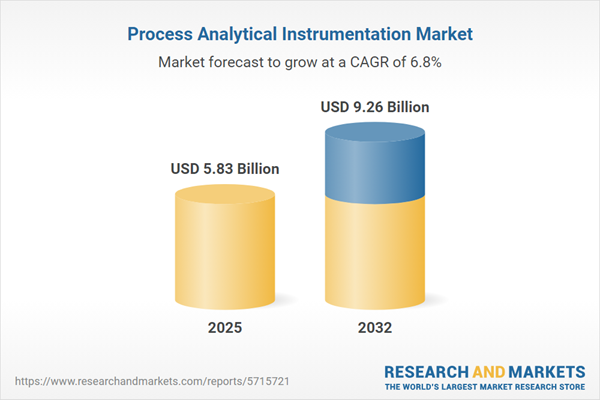Speak directly to the analyst to clarify any post sales queries you may have.
The process analytical instrumentation market is advancing steadily, propelled by digitalization, automation, and compliance demands. Technology integration is transforming how industries monitor, optimize, and ensure the quality of complex processes, highlighting the sector’s crucial role across global manufacturing.
Market Snapshot: Growth Trajectory for Process Analytical Instrumentation
The Process Analytical Instrumentation Market grew from USD 5.49 billion in 2024 to USD 5.83 billion in 2025, and is projected to expand at a CAGR of 6.75%, reaching USD 9.26 billion by 2032.
Growth is fueled by the convergence of digitalization, operational efficiency mandates, and regulatory pressures—all accelerating technology adoption across diverse process sectors.Scope & Segmentation: Comprehensive Market Coverage
- Instrument Types: Chromatographic Instruments (gas, liquid), Electrochemical Devices (conductivity meters, electrochemical sensors, pH meters), Mass Spectrometers, Particle Size Analyzers, Spectroscopic Instruments (IR, Raman, UV-Visible), and Thermal Analysis Instruments.
- Analysis Types: At-Line, In-line, Off-Line, and On-Line Instruments, each supporting distinct operational contexts from controlled labs to real-time production environments.
- Measurement Parameters: Chemical Composition, Contaminant Detection, Environmental Parameters, Flow & Pressure, and Physical Properties (like viscosity and density) enable flexibility in application and compliance.
- End-User Applications: Biotechnology (cell culture, genomics, proteomics), Chemicals & Petrochemicals (catalysis, polymer analysis, process optimization), Food & Beverages (contaminant testing, food safety, nutritional analysis), Pharmaceuticals (drug development, formulation, quality control), Semiconductor & Electronics, Water & Wastewater Treatment.
- Mode of Deployment: Benchtop Instruments deliver comprehensive performance in central facilities, while Portable or Handheld Devices support on-site and field operations.
- Regions: Americas (North America, Latin America, including key countries), Europe, Middle East & Africa (Western Europe, Middle East, Africa with dedicated markets), and Asia-Pacific (including major industrializing countries such as China, India, Japan, and others).
- Key Companies: Ab Sciex LLC, ABB, Agilent Technologies, Mettler-Toledo, Shimadzu, Siemens, Thermo Fisher Scientific, Waters Corporation, and other leading instrumentation providers with global reach and R&D capabilities.
Key Takeaways for Decision Makers
- Process analytical instrumentation is a strategic enabler of precision and quality assurance in sectors ranging from pharmaceuticals to food processing.
- The shift to integrated, on-line and in-line analytics supports continuous process improvement and reduces operational risk through real-time data-driven interventions.
- Emerging technologies such as artificial intelligence and machine learning allow organizations to convert complex data streams into actionable insights, enhancing predictive capabilities and maintenance planning.
- Miniaturization and mobile devices are democratizing access to analytical capabilities, driving faster decision-making on the production floor and in the field.
- Innovation ecosystems, including partnerships with process equipment suppliers and research institutions, are leading to rapid development of modular and cloud-connected solutions.
- Tailored solutions, addressing segment-specific requirements and deployment needs, are essential to meet both compliance and performance objectives for different industries.
Tariff Impact and Strategic Responses
Recent U.S. tariffs on imported analytical instruments and components have impacted global supply chains, causing recalibration of sourcing and production strategies. Many organizations are diversifying suppliers, investing in local capacities, or forming regional partnerships to mitigate cost and supply risks. These dynamics benefit providers with onshore assembly while incentivizing multinational manufacturers to innovate through joint ventures and flexible procurement frameworks.
Methodology & Data Sources
This report uses a robust methodology, incorporating both primary interviews with sector experts and secondary research from authoritative publications. Thorough data triangulation and validation by industry panels ensure insights that reflect current technologies, market conditions, and emerging trends.
Why This Report Matters
- Enables senior leaders to benchmark technology adoption and supply chain strategies within a rapidly changing regulatory landscape.
- Equips organizations to align future investments with operational and compliance drivers, supporting both efficiency and sustainability goals.
- Delivers rigorous competitive profiling and actionable recommendations, empowering market positioning and strategic foresight.
Conclusion
Process analytical instrumentation is at the forefront of industrial modernization, offering the agility and data integration required for quality-driven, resilient operations. Decision makers who leverage these insights will strengthen their competitive position in a dynamic market.
Additional Product Information:
- Purchase of this report includes 1 year online access with quarterly updates.
- This report can be updated on request. Please contact our Customer Experience team using the Ask a Question widget on our website.
Table of Contents
3. Executive Summary
4. Market Overview
7. Cumulative Impact of Artificial Intelligence 2025
Companies Mentioned
The companies profiled in this Process Analytical Instrumentation market report include:- Ab Sciex LLC by Danaher Corporation
- ABB Ltd.
- Agilent Technologies, Inc.
- Bruker Corporation
- Carl Zeiss AG
- Emerson Electric Co.
- Endress+Hauser Group Services AG
- F. Hoffmann-La Roche Ltd.
- Hach Company
- Horiba Ltd.
- Hovione
- Merck KGaA
- Mettler-Toledo International, Inc.
- MKS Instruments, Inc.
- NEO Monitors AS by The Nederman Group
- PROCONEX, INC.
- Schneider Electric SE
- Sensum d.o.o.
- Servomex Group Limited
- Shimadzu Corporation
- Sick AG
- Siemens AG
- Swagelok Company
- TEKTRONIX, INC.
- Thermo Fisher Scientific Inc.
- Waters Corporation
Table Information
| Report Attribute | Details |
|---|---|
| No. of Pages | 194 |
| Published | November 2025 |
| Forecast Period | 2025 - 2032 |
| Estimated Market Value ( USD | $ 5.83 Billion |
| Forecasted Market Value ( USD | $ 9.26 Billion |
| Compound Annual Growth Rate | 6.7% |
| Regions Covered | Global |
| No. of Companies Mentioned | 27 |









